See also
- Brookhaven National Laboratory
- Brookhaven Graphite Research Reactor, predecessor to HFBR at Brookhaven National Laboratory
- Brookhaven Medical Research Reactor (BMRR), another reactor which operated at Brookhaven National Laboratory
High Flux Beam Reactor (HFBR) was a research reactor which was located at Brookhaven National Laboratory, a United States Department of Energy national laboratory located in Upton, New York, on Long Island, approximately 60 miles east of New York City. [1] A successor to the Brookhaven Graphite Research Reactor, the HFBR operated from 1965 until 1996 and has been partially decommissioned. [2]
The primary purpose of the HFBR was to produce neutrons for multiple scientific uses. The reactor provided a source of neutrons for multidisciplinary scientific research in materials science, chemistry, biology, and physics. The reactor was used in the formulation of Nobel Prize-winning theories of cooperative ordering in large collections of atoms . [1]
The reactor first reached criticality on Halloween, October 31, 1965. About twice as large as the preceding BGRR, HFBR initially operated at a thermal power level of 40 megawatts. Following an equipment upgrade in 1982, the reactor was operated at up to 60 megawatts thermal; a safety reanalysis resulted in HFBR being shut down in 1989 and being limited to 30 megawatts thermal upon restart in 1991. [3] [2]
The HFBR shut down in December 1996 for routine maintenance and refueling. While shutdown, a leak of tritiated water was identified by routine sampling of ground water from wells located adjacent to the reactor's spent fuel pool. Upon further investigation a leak was discovered in the spent fuel pool that released tritium-contaminated water into the ground. The reactor remained shut down for three years for safety and environmental reviews. In January 1998, all the spent fuel was removed and shipped off site to allow for the insertion of a stainless steel liner in the spent fuel pool for the restart of the reactor. However, in November 1999, the Department of Energy decided to permanently shut down HFBR. [3] [2]
The HFBR was a heavy water cooled and moderated, enriched uranium fueled research reactor. The reactor core consisted of 28 individual fuel assemblies arranged in a close-packed array. The fuel material was enriched uranium alloyed in aluminum and clad with aluminum in curved plates. Heavy water (D2O) served as the moderator/neutron reflector and primary coolant. The reactor vessel was fabricated from an aluminum alloy and contained the active core, reflector, and control rods. The vessel consists of an 82-inch diameter spherical section welded to a 46-inch diameter cylinder. The overall height of the vessel assembly was 24.75 feet. There were nine horizontal beam entry tubes that are integral parts of the vessel's spherical section. The core region provided space and access for 16 experimental facilities. [4] [5] [6]
The reactor was housed within a confinement structure topped by a semi-hemispherical dome. The reactor sat inside a confinement building constructed of welded steel plates supported by an I-beam framework that rests on a cylindrical base. The inside diameter of the hemisphere at its base is 176 feet 8 inches. The cylindrical base is 22 feet 4 inches high and rests on a bed plate that is bolted to the reinforced concrete foundation ring. The foundation of the confinement building is a 5 ft. thick reinforced concrete mat bearing on the soil beneath the building. The interior of the confinement building contained the reactor and biological shield and was divided into equipment, experimental, balcony, and operations levels. The operations level contained the control room, instrument and maintenance shops, labs and offices. The equipment level contained the spent fuel pool water purification system, pumps and heat exchangers, cooling systems, and the spent fuel pool. The experimental level was for scientific users. The reactor biological shield, which surrounded the reactor, occupied the central portion of this level. A large open space surrounding the biological shield housed experimental equipment and there were labs and offices along the perimeter wall. Offices, locker rooms, toilets, and HVAC equipment were located on the balcony. The confinement building has four access points: a personnel airlock; a forklift airlock; and two tractor-trailer airlocks, one located on the experimental level and one on the equipment level. [6]
Nine neutron beam lines extended from the HFBR in a radial spoke pattern. Up to 15 experiments could be run concurrently on the nine beam lines. Two reactor operators and two supervisors crewed the HFBR control room around the clock. [4] In addition to the beam lines, seven sample irradiation thimbles for neutron activation experiments were provided which extended from the spherical reactor vessel towards the nuclear fuel. [2]
As a research reactor, HFBR never had a power conversion system to generate electricity. Heat from the nuclear reactions was transferred from the circulating heavy water moderator and coolant to a secondary cooling loop of ordinary water which flowed through cooling towers located west of the HFBR confinement. [7]
Notably, the reactor produced its greatest neutron flux outside of the core, rather than within, which allowed for greatest options in the design of experiments. [1]
During 1993, the HFBR underwent safety upgrades as well as installation of new scientific instruments. [4]
External to the reactor building, and shared with the previously constructed BGRR, was the Reactor Bypass Filter Facility (RBFF). This facility provided improved air cleaning prior to exhaust to the atmosphere in the unlikely event of a fuel element failure at either the BGRR or the HFBR. It also provided sufficient air cleaning to allow the use of air cooling as a method of combating a graphite fire at the BGRR. The facility was placed into operation in 1965. [5]
On March 31, 1994, a small fire broke out in one of the beam line experiments being conducted on the experimental floor outside of the reactor and biological shield. The reactor, associated reactor operations systems, and safety systems were not involved in the fire. [8] [7]
The experiment studying the decay of lanthanum-148, named TRISTAN, which burned contained a cylindrical capsule of 5 grams of uranium approximately 1 inch in diameter and 1 ½ inches tall. The capsule had been exposed to neutrons from a reactor beam line. Solid and gaseous fission products, including gaseous iodine-131, had been produced during the experiment and were released in the fire. Smoke from the fire was identified by on-duty personnel approximately 2:20 a.m.; the reactor was shut down at 2:45 a.m. and the HFBR confinement evacuated at 3:47 a.m. At 4:51 a.m. BNL officials declared an Alert emergency, the second lowest of four emergency classifications. The fire self-extinguished after the electrical power supply to the experiment was turned off. [8]
Seven laboratory personnel were minimally contaminated by radionuclides entrained in the smoke from the fire. All seven were decontaminated at showers at the lab and released to return home. [8]
At the time of the fire, a minute amount of radiation was released to the atmosphere from the vent stack serving BGRR and HFBR. The amount of radiation released was compared to a few seconds to typical background radiation. BNL officials and New York state health officials agreed that there was no danger posed to the public from the release. [7] [8]
HFBR was shut down for multiple investigations until June 1994, then restarted. The TRISTAN experiment was permanently discontinued. [7]
The decontamination and decommissioning of the HFBR complex, consisting of multiple structures and systems to operate and maintain the reactor, was completed from 1999 until 2009. The control rod blades were removed and shipped offsite in 2009. The emptied and cleaned HFBR dome, which still contains the irradiated reactor vessel is maintained under surveillance. [3] Final decommissioning of the HFBR confinement is to be performed at the end of a radionuclide decay period not exceeding 65 years. [2]
The red and white, 320-foot-tall exhaust stack constructed for the BGRR in 1949 and later shared with the HFBR was a distinctive landmark for the area until its demolition in 2020. [9]

Brookhaven National Laboratory (BNL) is a United States Department of Energy national laboratory located in Upton, Long Island, and was formally established in 1947 at the site of Camp Upton, a former U.S. Army base and Japanese internment camp. Its name stems from its location within the Town of Brookhaven, approximately 60 miles east of New York City. It is managed by Stony Brook University and Battelle Memorial Institute.

The pebble-bed reactor (PBR) is a design for a graphite-moderated, gas-cooled nuclear reactor. It is a type of very-high-temperature reactor (VHTR), one of the six classes of nuclear reactors in the Generation IV initiative.

The High Flux Australian Reactor (HIFAR) was Australia's first nuclear reactor. It was built at the Australian Atomic Energy Commission Research Establishment at Lucas Heights, Sydney. The reactor was in operation between 1958 and 2007, when it was superseded by the Open-pool Australian lightwater reactor, also in Lucas Heights.
Passive nuclear safety is a design approach for safety features, implemented in a nuclear reactor, that does not require any active intervention on the part of the operator or electrical/electronic feedback in order to bring the reactor to a safe shutdown state, in the event of a particular type of emergency. Such design features tend to rely on the engineering of components such that their predicted behaviour would slow down, rather than accelerate the deterioration of the reactor state; they typically take advantage of natural forces or phenomena such as gravity, buoyancy, pressure differences, conduction or natural heat convection to accomplish safety functions without requiring an active power source. Many older common reactor designs use passive safety systems to a limited extent, rather, relying on active safety systems such as diesel powered motors. Some newer reactor designs feature more passive systems; the motivation being that they are highly reliable and reduce the cost associated with the installation and maintenance of systems that would otherwise require multiple trains of equipment and redundant safety class power supplies in order to achieve the same level of reliability. However, weak driving forces that power many passive safety features can pose significant challenges to effectiveness of a passive system, particularly in the short term following an accident.

The High Flux Isotope Reactor (HFIR) is a nuclear research reactor at Oak Ridge National Laboratory (ORNL) in Oak Ridge, Tennessee, United States. Operating at 85 MW, HFIR is one of the highest flux reactor-based sources of neutrons for condensed matter physics research in the United States, and it has one of the highest steady-state neutron fluxes of any research reactor in the world. The thermal and cold neutrons produced by HFIR are used to study physics, chemistry, materials science, engineering, and biology. The intense neutron flux, constant power density, and constant-length fuel cycles are used by more than 500 researchers each year for neutron scattering research into the fundamental properties of condensed matter. HFIR has about 600 users each year for both scattering and in-core research.
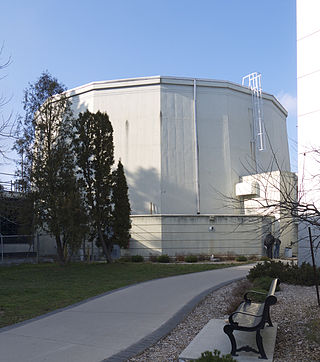
The McMaster Nuclear Reactor (MNR) is a 5 MWth open pool reactor located on the campus of McMaster University, in Hamilton, Ontario, Canada.
The Whiteshell Reactor No. 1, or WR-1, was a Canadian research reactor located at AECL's Whiteshell Laboratories (WNRL) in Manitoba. Originally known as Organic-Cooled Deuterium-Reactor Experiment (OCDRE), it was built to test the concept of a CANDU-type reactor that replaced the heavy water coolant with an oil substance. This had a number of potential advantages in terms of cost and efficiency.
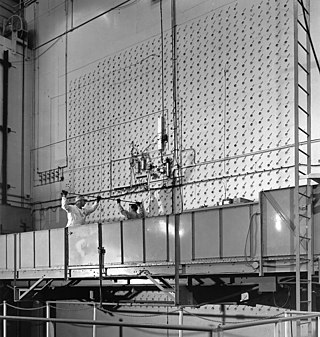
The X-10 Graphite Reactor is a decommissioned nuclear reactor at Oak Ridge National Laboratory in Oak Ridge, Tennessee. Formerly known as the Clinton Pile and X-10 Pile, it was the world's second artificial nuclear reactor, and the first designed and built for continuous operation. It was built during World War II as part of the Manhattan Project.

The Advanced Test Reactor (ATR) is a research reactor at the Idaho National Laboratory, located east of Arco, Idaho. This reactor was designed and is used to test nuclear fuels and materials to be used in power plants, naval propulsion, research and advanced reactors. It can operate at a maximum thermal power of 250 MW and has a "Four Leaf Clover" core design that allows for a variety of testing locations. The unique design allows for different neutron flux conditions in various locations. Six of the test locations allow an experiment to be isolated from the primary cooling system, providing its own environment for temperature, pressure, flow and chemistry, replicating the physical environment while accelerating the nuclear conditions.
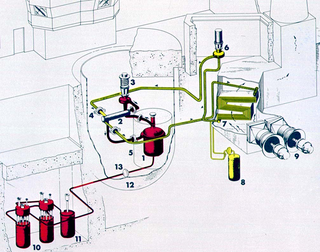
The Molten-Salt Reactor Experiment (MSRE) was an experimental molten salt reactor research reactor at the Oak Ridge National Laboratory (ORNL). This technology was researched through the 1960s, the reactor was constructed by 1964, it went critical in 1965, and was operated until 1969. The costs of a cleanup project were estimated at about $130 million.
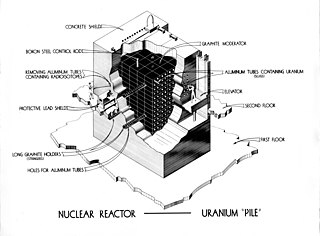
A graphite-moderated reactor is a nuclear reactor that uses carbon as a neutron moderator, which allows natural uranium to be used as nuclear fuel.
The Ford Nuclear Reactor was a facility at the University of Michigan in Ann Arbor dedicated to investigating the peaceful uses of nuclear power. It was a part of the Michigan Memorial Phoenix Project, a living memorial created to honor the casualties of World War II. The reactor operated from September 1957 until July 3, 2003. During its operation, the FNR was used to study medicine, cellular biology, chemistry, physics, mineralogy, archeology, anthropology, and nuclear science.

The Omega West Reactor (OWR) was an experimental nuclear reactor located at Los Alamos National Laboratory in Los Alamos NM. OWR was completed in 1956 and primarily used for scientific scale nuclear research until it was fully decommissioned in 1994. It operated 24 hours a day, five days a week until 1972, when it went to eight hours a day, five days a week operation. The original purpose of the reactor was to collect nuclear material properties in support of the United States nuclear weapons program. Other uses included production of useful medical isotopes. The reactor was capable of producing an external beam of neutrons via beam tubes which extended through the reactor shielding. These were provided for external neutron beam experiments including: neutron radiography, neutron capture studies, gamma ray studies, neutron cross section measurements and neutron activation studies.

Chicago Pile-5 (CP-5) was the last of the line of Chicago Pile research reactors which started with CP-1 in 1942. The first reactor built on the Argonne National Laboratory campus in DuPage county, it operated from 1954-1979.

The Washington State University Reactor (WSUR) is housed in the Dodgen Research Facility, and was completed in 1961. The (then) Washington State College Reactor was the brainchild of Harold W. Dodgen, a former researcher on the Manhattan Project where he earned his PhD from 1943 to 1946. He secured funding for the ambitious 'Reactor Project' from the National Science Foundation, the Atomic Energy Commission, and the College administration totaling $479,000. Dodgen's basis for constructing a reactor was that the College was primely located as a training facility for the Hanford site, as well as Idaho National Laboratory because there was no other research reactor in the West at that time. After completing the extensive application and design process with the help of contractors from General Electric they broke ground in August 1957 and the first criticality was achieved on March 7, 1961 at a power level of 1W. They gradually increased power over the next year to achieve their maximum licensed operating power of 100 kW.
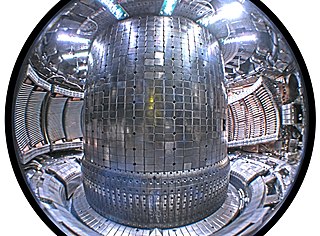
In nuclear fusion power research, the plasma-facing material (PFM) is any material used to construct the plasma-facing components (PFC), those components exposed to the plasma within which nuclear fusion occurs, and particularly the material used for the lining the first wall or divertor region of the reactor vessel.
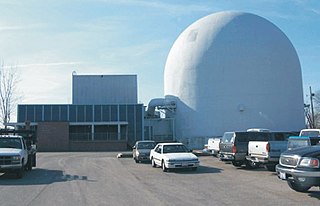
An organic nuclear reactor, or organic cooled reactor (OCR), is a type of nuclear reactor that uses some form of organic fluid, typically a hydrocarbon substance like polychlorinated biphenyl (PCB), for cooling and sometimes as a neutron moderator as well.
Brookhaven Graphite Research Reactor (BGRR) was a research reactor located at Brookhaven National Laboratory, a United States Department of Energy national laboratory located in Upton, New York, on Long Island, approximately 60 miles east of New York City. The BRGG operated from 1950 until 1968 and has been fully decommissioned.
Medical Research Reactor (MRR) was a research reactor which was located at Brookhaven National Laboratory, a United States Department of Energy national laboratory located in Upton, New York, on Long Island, approximately 60 miles east of New York City. The second of three reactors constructed at BNL, the MRR operated from 1959 until 2000 and has been partially decommissioned.
{{cite journal}}: Cite journal requires |journal= (help){{cite journal}}: Cite journal requires |journal= (help)